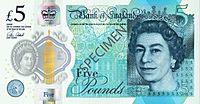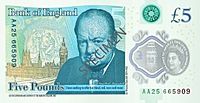Bank of England £5 note facts for kids
| (United Kingdom) | |
|---|---|
| Value | £5 sterling |
| Width | 125 mm |
| Height | 65 mm |
| Security features | See-through window with Queen's portrait, The '£' symbol in the window changes from purple to green, finely detailed Elizabeth Tower metallic image which is gold on the front and silver on the back, circular green foil patch contains letters spelling, ‘BLENHEIM’, coloured border which changes from purple to green when the note is tilted, silver foil patch, microlettering, textured print, EURion constellations, holograms |
| Paper type | Polymer |
| Years of printing | 1793–1944; 1945-1957; 1957-1963; 1963-1971; 1971-1990; 1990-2002; 2002-2016; 2016-present (current design) |
| Obverse | |
 |
|
| Design | Queen Elizabeth II |
| Design date | 13 September 2016 |
| Reverse | |
 |
|
| Design | Winston Churchill |
| Design date | 13 September 2016 |
The Bank of England £5 note, often called a fiver, is a type of banknote used in the United Kingdom. It's the smallest paper money value that the Bank of England currently prints. In September 2016, a new plastic (called polymer) £5 note was released. It shows Queen Elizabeth II on the front and Winston Churchill on the back. The older paper note, which had Elizabeth Fry on the back, was slowly removed from use and stopped being valid money after May 5, 2017.
Contents
History of the £5 Note
When the £5 Note Started
The Bank of England first started printing five pound notes in 1793. This happened because there wasn't enough gold available. Before this, in 1759, the ten pound note was introduced for similar reasons during the Seven Years' War. The £5 note became the smallest value note until 1797. The very first notes were written by hand for specific people. They only had writing on one side, showing who it was for, the date, and the cashier's signature.
The 'Restriction Period' for Money
In 1797, Britain was at war with France. This caused people to worry and rush to banks to exchange their notes for gold. This is called a "bank run." The Bank of England ran out of gold. Because of this, the Bank had to stop giving out gold for notes. They also started printing £1 and £2 notes. This time was known as the 'restriction period' because exchanging notes for gold was stopped.
The restriction period ended in 1821. The government wanted to make sure the value of money was stable. So, Britain went back to the gold standard on May 1, 1821. This meant you could again exchange your banknotes for gold at the bank. From 1853, printed notes took over from handwritten ones. The promise "I promise to pay the bearer on demand the sum of five pounds" was added. This promise is still on Bank of England notes today.
Changes to the £5 Note Design
Britain stopped using the gold standard in 1931. This meant banknotes could no longer be exchanged for gold. In 1945, a metal thread was added to the £5 note as a way to make it harder to copy.
From 1957, the old black and white notes were replaced with new notes printed on both sides. These first two-sided £5 notes were blue. They showed a picture of Britannia on the front and a lion on the back. In 1963, the notes changed again. This time, Queen Elizabeth II appeared on the front for the first time. Britannia moved to the back.
From 1971, the notes started featuring famous British people on the back. The first was the Duke of Wellington, a famous soldier. In 1990, the notes became multicoloured, mostly turquoise-blue. These notes showed George Stephenson, who helped build railways. They also had a new "windowed" metal thread. This thread looks like a broken line, but it becomes a solid line when you hold the note up to the light.
Moving to Plastic Notes
In 2013, the Bank of England announced a big change. The next £5 note would feature Winston Churchill instead of Elizabeth Fry. They also said the new notes would be made of polymer, a type of plastic, instead of cotton paper. The Bank explained that plastic notes would be cleaner, safer from fakes, and last much longer. They also said plastic notes were better for the environment.
The new plastic £5 note was released on September 13, 2016. For a while, both the old paper notes and the new plastic notes were valid. But on May 5, 2017, the old paper notes stopped being legal money. However, you can still exchange any old Bank of England notes for their value at the Bank of England itself.
Designs of the £5 Note
Past and Present £5 Note Designs
| Note | First issued | Last issued | Stopped being legal money |
Colour | Size | Design | Interesting facts |
|---|---|---|---|---|---|---|---|
| White (1793) | 1793 | 1944 | 1 March 1946 | Black and white (printed on one side) |
200 × 113 mm (size could change) |
||
| White (1945) | 1945 | 1957 | 13 March 1961 | Black and white (printed on one side) |
211 × 133 mm | First to have a metal thread for safety | |
| Series B | 21 February 1957 | 1963 | 27 June 1967 | Blue | 158 × 90 mm | Front: Helmeted Britannia Back: Lion |
|
| Series C | 21 February 1963 | 1971 | 31 August 1973 | Blue | 140 × 85 mm | Front: Queen Elizabeth II Back: Seated Britannia |
First £5 note with the Queen's picture |
| Series D | 11 November 1971 | 1990 | 29 November 1991 | Mostly blue | 145 × 78 mm | Front: Queen Elizabeth II Back: Duke of Wellington |
|
| Series E | 7 June 1990 | July 2002 | 21 November 2003 | Many colours (mostly turquoise-blue) | 135 × 70 mm | Front: Queen Elizabeth II Back: George Stephenson |
Notes from March 1993 had bolder "£5" symbol |
| Series E (variant) | 21 May 2002 | 2016 | 5 May 2017 | Many colours (mostly green) | 135 × 70 mm | Front: Queen Elizabeth II Back: Elizabeth Fry |
The last £5 note made of paper |
| Series G (polymer) | 13 September 2016 | Many colours (turquoise) | 125 × 65 mm | Front: Queen Elizabeth II Back: Winston Churchill |
The first Bank of England note made of plastic |
The £5 Note You See Today
The Series G (polymer) note is the only £5 note that is currently valid money. The older paper Series E notes were taken out of use after a period where both types were accepted. This period ended on May 5, 2017.
How Many £5 Notes Are Used?
The Bank of England is in charge of printing and giving out notes. This makes sure there's enough money for everyone in the United Kingdom. They keep track of how many notes are being used at any time. The number of £5 notes in use was highest in 1979. This was before the £50 note was brought back into use.
| End of Year | Total Value of Notes (£) | Number of Notes in Use |
|---|---|---|
| 1979 | 3,694,000,000 | 738,800,000 |
| 2004 | 1,025,000,000 | 205,000,000 |
| 2005 | 1,054,000,000 | 211,000,000 |
| 2006 | 1,051,000,000 | 210,000,000 |
| 2007 | 1,100,000,000 | 220,000,000 |
| 2008 | 1,242,000,000 | 248,000,000 |
| 2009 | 1,342,000,000 | 260,000,000 |
| 2010 | 1,245,000,000 | 249,000,000 |
| 2011 | 1,355,000,000 | 271,000,000 |
| 2012 | 1,477,000,000 | 295,000,000 |
| 2013 | 1,526,000,000 | 305,000,000 |
| 2014 | 1,540,000,000 | 308,000,000 |
| 2015 | 1,601,000,000 | 320,000,000 |
| 2016 | 1,645,000,000 | 329,000,000 |
| 2017 | 1,912,000,000 | 382,400,000 |
| 2018 | 1,910,000,000 | 382,000,000 |
| 2019 | 1,979,000,000 | 396,000,000 |
| 2020 | 2,068,000,000 | 414,000,000 |
| 2021 | 2,034,000,000 | 407,000,000 |
| 2022 | 1,995,000,000 | 399,000,000 |
See also


